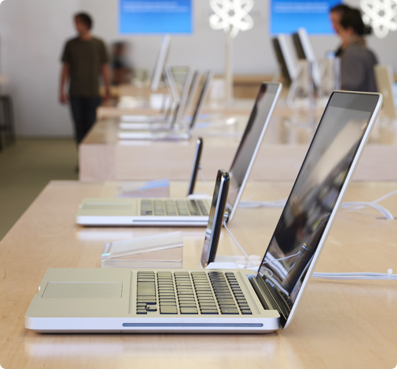What Can Damage Apple's Amazing Customer Experience and Brand?
Network Congestion Will Be a Challenge Even to Steve Jobs
Apple always offers a great customer experience. Yet it has chosen partners who fall down on the job. And, as you can do more with Apple products, network congestion can make the experience less than ideal. Here’s a look at where the Apple experience is falling down.
Apple has set the bar for customer experience in so many ways. Let’s begin to count them:
- roduct/service design
- Product/service introduction
- Out-of-the-box experience
- Service (iTunes) experience
- User experience
- Brand experience seduction and advocacy
- Retail experience
- Customer service in the store
- Customer service on the phone
- Returns/replacements/exchanges
Recently, I’ve been impressed by the number of stories I’ve head from Apple users about amazing customer service experiences around returns, exchanges, and upgrades with no questions asked—essentially exceeding customers’ expectations. I’ve also heard lots of great stories about Apple’s skill at setting (and exceeding) expectations for deliveries of scarce products.
I’ve also been noticing the difference between the Apple retail experience and magnetism and that of all other stores. For example, in downtown San Francisco, the two-story store is always packed, yet there’s ample room for several dogs to be lying on the floor near their owners, and nobody has to wait too long before they can get their hands on an iPad to try. And the checkout lines are expedited. In sleepy Ardmore, Pennsylvania—in a downtown area that was originally designed to serve rich Main Line women who had nothing to do all day except shop and lunch with their friends—all the department stores and boutiques are now virtually abandoned since that lifestyle was replaced by busy two (+)-career families. The chic shopping section of Ardmore is now a ghost town. But there are two vibrant retail establishments: Trader Joe’s and the Apple Store. You walk down a nearly empty sidewalk to the Apple Store, open the door, and feel like you’ve entered a different universe. It’s teaming with customers and activity. Your immediate thought is, “Buy Apple Stock!”
Partnering with Suppliers Who Can’t Match the Apple Experience
Since Apple has raised the bar so high, it’s tricky for Apple to find partners who are up to the challenge of supporting the experience that Apple users have become addicted to. Given the care with which Steve Jobs imbues every atom of the customer experience he creates when designing a product or service, why doesn’t Apple have better quality control for vetting its partners’ experiences?

© 2010 Apple
Why Does Apple Stick with AT&T in the U.S.??
So the question I’ keep asking myself, and have been asking ever since the launch of the iPhone, is why the near-exclusive partnership with AT&T (in the U.S.)—a brand in mobile telephony that has become synonymous with lousy coverage? In the U.S., Apple has persisted in giving AT&T long periods of exclusivity for the iPhone. Verizon is still dithering about when its iPhone will become available.
But why? AT&T has been notorious in letting customers down. Let’s count the ways:
- Spotty wireless coverage in the U.S.
- Too little bandwidth for data-intensive users
- Bad customer experience dealing with AT&T
- Hacking of iPad Users’ Data
- AT&T’s handling of the iPhone 4 Launch, including a second data breach!
Adrian Kingsley-Hughes has a wonderful post entitled, “Oh AT&T, could you have FAILed any harder on iPhone 4 pre-order day?” In the post, he says, “I really don’t think so…” then he lists all the failures on AT&T’s side….and goes on to say:
“This is a complete and utter mess, and it’s amazing to think of Apple standing on the sidelines looking on at this disastrous handling of the pre-order of a flagship product.”
Why Did the iPhone 4 Not Work During Jobs’ Announcement?
On June 7th, Steve Jobs announced the next iPhone—the product whose popularity swamped AT&T’s infrastructure and reportedly caused Apple to halt order acceptance after 600,000 orders were placed. Less widely reported, but important, was the glitch that occurred DURING the announcement itself. As everyone knows, Apple announcements are carefully staged and prepared. So it came as a surprise to everyone, including Steve Jobs, when he couldn’t do his iPhone 4 demo! He wound up having to ask everyone in the audience to turn off their computers and phones so that he could have enough bandwidth to complete the demo. Jordan Robertson reported this in “Data congestion thwarts Steve Jobs' iPhone demo,” an AP wire story picked up by The Washington Post, Forbes, and many other news sources.
Network Data Congestion Will Damage the Customer Experience
One of the people who noticed this glitch at the iPhone 4 announcement was my husband, Tom Hagan. He has been ruminating about wireless spectrum capacity recently, ever since he attended my brother Andrew Seybold’s Wireless University seminar in Las Vegas this Spring. As Andy described in detail how spectrum is allocated and managed, Tom’s head was spinning. Then, during a break, Andy and several other folks whipped out their smartphones to show each other their video-on-demand capabilities. When Andy played his video, it looked great! When the second user launched his, it was slower. By the time the fifth user in the group tried to launch a video, all of them started to degrade. Tom’s “Aha!” was that there’s no way our current wireless infrastructure will deliver the kind of user experience that people are expecting.
Here are some of his thoughts on this topic, from his post, “Video on Cell Phones? Not Soon”:
“One of the things that ‘everybody knows that just ain’t so’ is that we will all soon be watching videos on our cell phones...
Sign in to download the full article
0 comments
Be the first one to comment.



